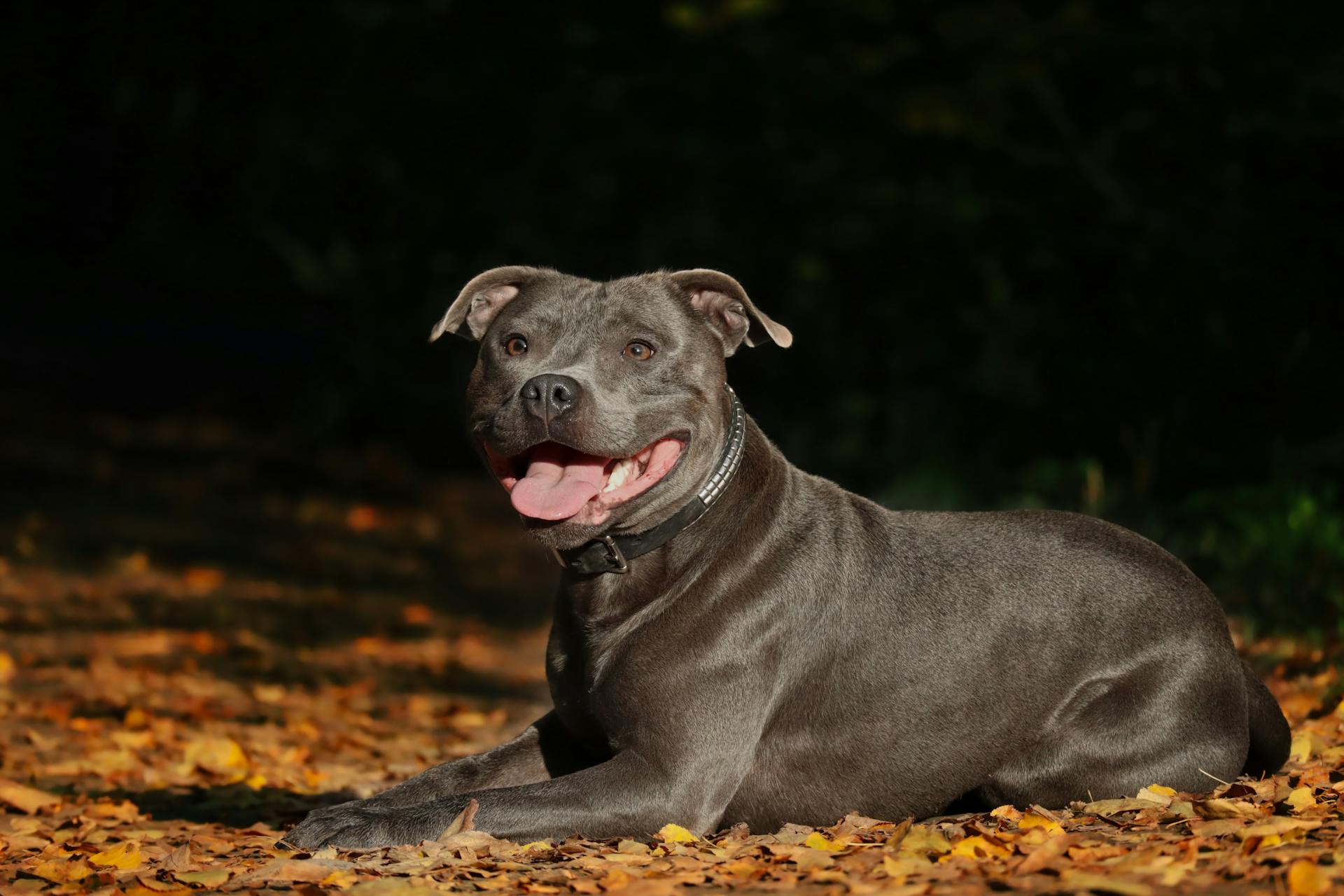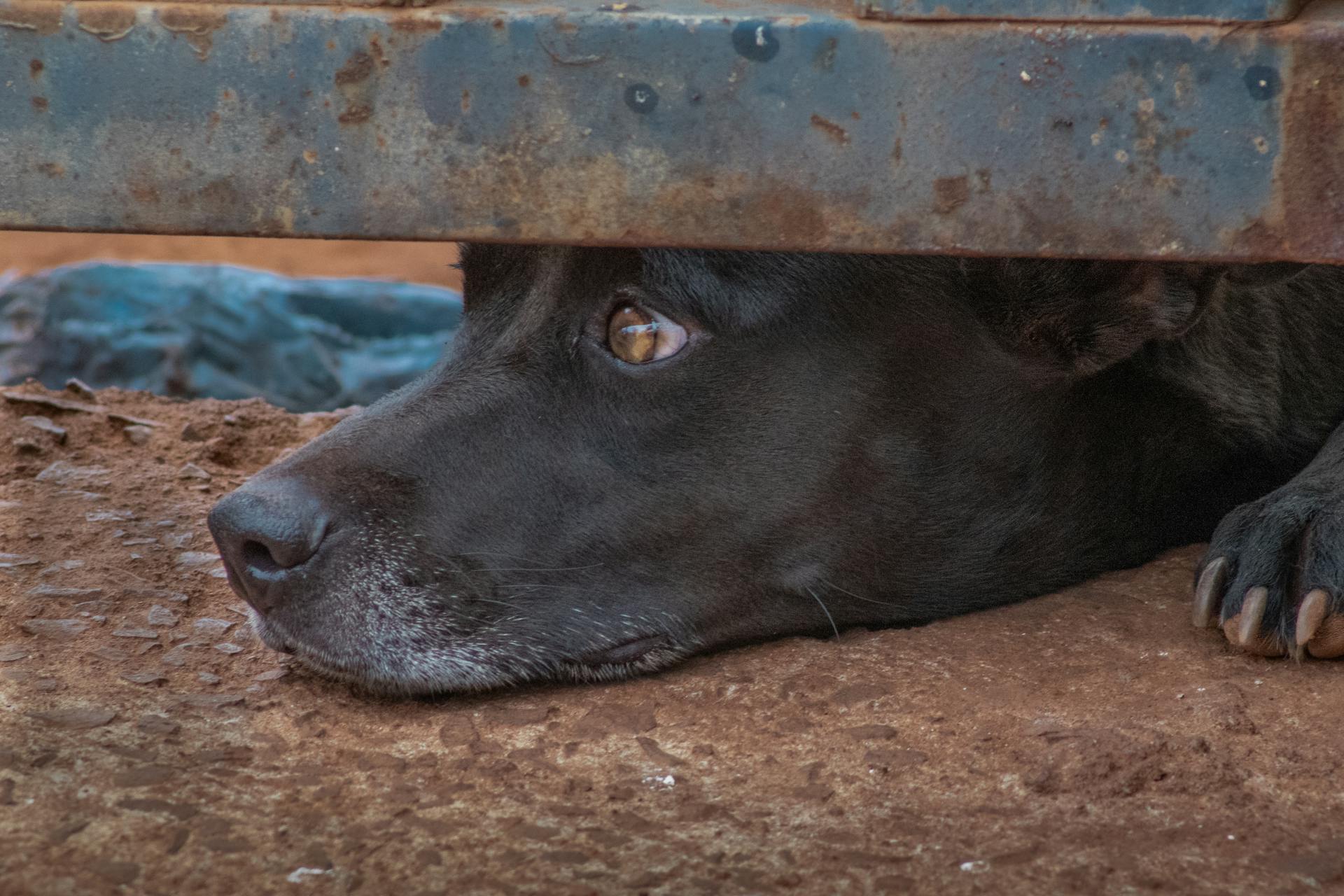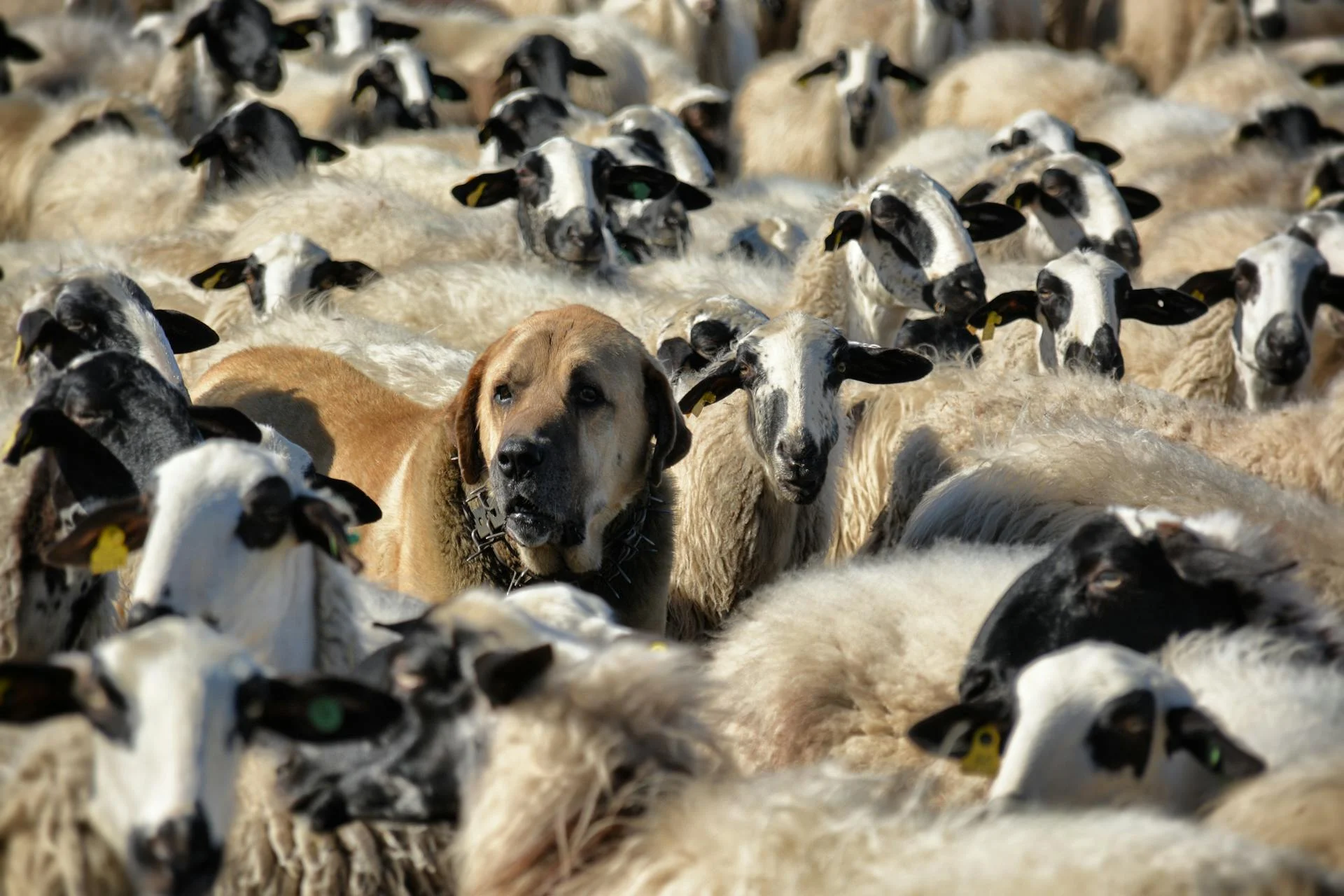
Staffy Behaviour Problems can be a challenge, but understanding the root causes is key to addressing them. Staffies are bred for companionship and can become anxious if left alone for extended periods.
Their high energy levels can lead to destructive behavior if not exercised sufficiently. Regular exercise is essential to prevent boredom and frustration.
Staffies are intelligent and responsive to training, but consistency and positive reinforcement are crucial. They thrive on clear boundaries and reward-based learning.
Housebreaking can be a struggle for some Staffy owners, but establishing a routine and using positive reinforcement techniques can help.
Staffy Behaviour Problems
Staffy Behaviour Problems can be a handful, especially when it comes to destructive behaviour. Staffies are born with a predisposition for chewing, possibly more so than other breeds, and it's typical Staffy behaviour to chew on things.
Providing your Staffy with a wide variety of tough toys that can withstand their constant, severe chewing characteristic is essential. This can help redirect their energy and satisfy their desire to chew.
Staffy owners know that a high fence is a must, especially if your Staffy prefers abandoning the garden rather than destroying it.
Some common behavioural issues in Staffies include dog aggression, pulling on the leash, and general disobedience. Training and consistency are key to addressing these issues.
Here are some common Staffy behaviour problems and their solutions:
Remember, every dog is different, and what works for one Staffy may not work for another.
Dog Behavioral Issues
Staffies can be prone to separation anxiety, so it's essential to provide them with a comfortable and stimulating environment when you're not around. This can include creating a "safe space" in your home with everything your Staffy needs.
Staffies are intelligent and quick to pick up new skills, but they can be a bit stubborn and like pushing limits. Early socialisation and consistent training are crucial to help them mature into manageable adults.
Separation anxiety is a common issue among Staffies, and it's often caused by boredom or frustration when left alone for long periods. Staffies don't do well with being confined for long hours, so it's essential to keep them active and engaged.
For another approach, see: Dog Behaviour When Owner Pregnant
Staffies can be prone to destructive behaviour, especially when they're bored or left alone. Providing them with tough toys and a secure area to play can help alleviate this issue.
Staffies are naturally social animals and love to join in on family activities. However, they can be wary of other dogs, especially if they're not socialised properly. Early socialisation and positive reinforcement can help them become confident and calm around other dogs.
Staffies can be aggressive towards other dogs, especially if they're not trained or socialised correctly. This can be a result of fear or anxiety, so it's essential to address this issue early on with professional training and socialisation.
Staffies are known for their love of chewing, and it's not just a phase - it's a natural behaviour for them. Providing them with plenty of tough toys and chews can help save your furniture and belongings.
Staffies can be prone to pulling on the leash when walking, which can be a result of excitement or lack of training. Consistent training and positive reinforcement can help them learn to walk calmly by your side.
Staffies are highly trainable, but they do require consistent training and socialisation to become well-behaved adults. With patience, love, and the right training, your Staffy can become a confident and loving companion.
Additional reading: Dog Training for Fear Aggression
Strong Woman Pulls 60kg Mastiff
I've seen some impressive strength in action, like the 50kg woman who can pull a 60kg Mastiff. This is a great example of how some breeds can be quite strong.
In the case of King, a Mastiff who was adopted by Kira and Ruben, he was struggling to be controlled on walks due to his size and pulling. This was a problem that needed to be addressed.
It's clear that some breeds, like Mastiffs, require more exercise and training to manage their strength and size. This is especially important for owners who want to ensure their pet's behavior is well-behaved.
A single session with a trainer was enough to help Kira and Ruben gain control over King's pulling. This shows that with the right guidance, even the strongest dogs can learn to behave.
Additional reading: French Mastiff Health Problems
Leash and Walking Issues
Staffy owners know that these dogs can be a handful when it comes to leash manners. They often pull on the lead, making walks a chore.
This behavior can be frustrating and even painful, especially for smaller owners. Fortunately, there are training techniques that can help curb this behavior.
Staffies are powerful dogs that can pull their owners off their feet if they're not careful. Turning aside as soon as they start to pull can help them understand that pulling doesn't get them what they want.
Stopping cold when they pull is another effective technique. It's essential to be consistent and not start walking again until they're calm and listening.
Some Staffies may also exhibit aggression towards other dogs, especially if they're not socialized properly. This can be a major issue, especially in dog parks where they may encounter other dogs.
If your Staffy is grabbing the leash, it's essential to address this behavior immediately. Freeze your actions and clap your hands at the precise moment your dog opens its mouth to grab the leash.
Here are some common leash and walking issues that Staffy owners face:
- Pulling on the lead
- Grabbing the leash
- Refusing to walk on a leash
- Aggression towards other dogs
Destructive Behaviour
Staffies are born with a predisposition for chewing, which can lead to a lot of destructive damage in a short period.
Their strong jaws and powerful build make them capable of causing significant damage to your home furnishings and personal belongings.
Providing your Staffy with a wide variety of tough toys that can withstand their constant, severe chewing characteristic is essential.
Doing so can also be therapeutic for your Staffy, as chewing can be a way for them to release pent-up energy and calm down.
Staffies have an insatiable desire to chew on things, and it's not just to kill time - it's a natural behaviour for them.
If your Staffy prefers abandoning the garden rather than destroying it, you must build a high fence to prevent them from escaping and causing more damage.
A tired dog is a good dog, and Staffies are no exception - if they're left alone in the garden for any length of time, they'll find something to entertain themselves, and destroying your flowerbeds might be on their list of possible activities.
Noise and Barking Issues
Staffies can be prone to excessive barking, especially if they're not socialized, exercised, or trained properly. One of the main causes of nuisance barking in Staffies is separation anxiety.
Staffies are known to love their family's company and can become distressed when left alone. This can lead to persistent barking and other unwanted behaviors. Brad, an experienced dog writer, notes that Staffies often don't appreciate being left alone for long periods.
It's not uncommon for Staffies to bark more than other breeds, and some may even develop separation anxiety. This can be addressed with proper training and socialization.
Barking
Staffies are known to bark excessively if they're not properly trained, but socialization and regular exercise can help minimize this issue.
Separation anxiety is a common cause of nuisance barking in Staffies, as they tend to be extremely attached to their family and don't like being left alone for long periods.
Some Staffies will bark more than others, but it's often a sign of a deeper issue that needs to be addressed.
Check this out: Why Do Great Pyrenees Bark so Much
Brad, an experienced dog writer, has observed that Staffies are highly social animals that thrive on interaction with their family.
Staffies need to be trained to be calm and relaxed when left alone, or they may resort to excessive barking.
It's essential to recognize that some barking is normal, but persistent barking can be a sign of a problem that needs to be solved.
The Uncontrollable Screaming
The uncontrollable screaming is a common issue many dog owners face. This behavior can be caused by separation anxiety, as seen in our clients' Top 10 behavioural issues.
Some dogs can get so anxious that they scream uncontrollably, as evident in the "after" video of the uncontrollable screaming Staffy. Massive improvement is possible with the right training.
This Staffy was able to completely ignore other dogs and stop pulling on the leash after just one session. This shows that with the right approach, even the most challenging issues can be addressed.
Related reading: Staffy Health Issues
Uncontrollable screaming can be a sign of underlying issues, such as separation anxiety or excitement/aggression towards other dogs. Rough play and or biting can also be related to this behavior.
With professional help, it's possible to see a significant improvement in your dog's behavior, as demonstrated by the Staffy's transformation.
Training and Behaviour
Staffies are born with a predisposition for chewing, possibly more so than other breeds, making it essential to provide them with tough toys that can withstand their constant chewing.
Staffordshire Bull Terriers are powerful dogs with strong jaws, capable of causing a lot of destructive damage in a short period.
To prevent this, you must provide your Staffy with a wide variety of tough toys that can withstand their severe chewing characteristic.
Staffies have an insatiable desire to chew on things, and it's not only to kill time; doing so can also be therapeutic.
Staffies are a very adaptable and trainable dog, but you do need to have patience when training, or their fun-loving personality can wear you out.
They just want to please and are always full of energy, making them a joy to be around.
However, their over-exuberance can lead to jumping, nipping, and barking, which can be challenging to manage.
To address this, it's essential to keep calm and ignore them until they are calm.
Staffies tend to be over-zealous with other dogs, which can lead to problems, especially if they're strong and hold tight.
To prevent this, it's crucial to teach them to walk away from a fight and not to engage with other dogs when they're excitable.
Staffies like to play fetching games, so spend some time teaching them to bring their ball back and hide it for them to find.
Positive-only dog training is a great motivator for training Staffordshire Bull Terriers, but it's essential to remember that treats should be used sparingly and not as a means to control the dog.
Consistent education and communication are key to training a Staffy, and it's essential to keep sessions short to avoid overwhelming them.
Here's an interesting read: Dog Problem Training
Staffies are keen to please their human and will play the clown or the serious role with ease, but they can also develop behavioral issues if not trained correctly.
The most prevalent behaviors that require professional training are dog aggression, biting the leash during the walk, excitable behavior, and a small amount of human aggression.
Staffies are not the type of breed that wants to constantly test you, and with consistent education and training, they can become well-behaved companions.
Intriguing read: Crate Training with Separation Anxiety
Recall and Exuberance
Staffies aren't deliberately disobedient, but they can be hard to recall because of a lack of proper communication. Practice calling your dog on leash in a controlled environment or fenced area, and let the leash trail on the ground while calling them to you in a pleasant and encouraging way.
Staffies need to understand your intentions and what you want from them, or they'll just bound away to investigate more interesting things. I've seen it happen with my own friends' dogs - they get distracted by a squirrel and forget all about their owner's calls.
To quell over-exuberant behavior, practice calm interaction with your dog. Don't turn on your 'excitement meter' when you arrive home, enter the home and interact in a calm way.
For your interest: Leash Aggression Dog Whisperer
Recall

Recall is a crucial aspect of a Staffie's training. The Staffie is generally not deliberately disobedient, but rather it stems from a lack of proper communication.
To improve recall, it's essential to start with short distances and controlled environments, such as a fenced area. Practice calling your dog on leash first. This will help your dog understand your voice and intentions.
Staffies need to understand your intentions and what you want from them. If they don't, they'll just bound away to investigate more interesting things. Call your dog to you in a pleasant and encouraging way, and let the leash trail on the ground.
Curious to learn more? Check out: Leash Aggression Dog
Over-Exuberance
If you have a Staffordshire Bull Terrier, you know they can be over-zealous. Over-zealous behavior is synonymous with most Staffordshire Bull Terriers.
Practicing calm interaction with your dog is key to quelling this over-exuberant behavior. Don’t turn on your ‘excitement meter’ when you arrive home, enter the home and interact in a calm way.
Recommended read: American Bull Staffy

The worst thing you can do with an excitable breed is to act in an excitable way, they will just match your behavior and ramp it up. This can lead to long term problems and mean that your dog never gets to go back to the dog park for fear of fights with other dogs.
Dog parks can be intimidating for puppies, especially near the entrance where established dogs like to check out who is requesting entry to their domain. This can give your puppy a lasting bad impression, which can later lead to dog aggression as your puppy reaches maturity.
Other puppies can bully and intimidate your dog, so don’t rush off to a dog park. Let your puppy enjoy pleasant experiences with well-behaved dogs or puppies.
If fully immunized, you can sit with your puppy on your lap in a public area or park, where it can watch the world from a safe place.
Discover more: Dog Zoomies and Biting
Health and Wellbeing
Staffy behaviour problems can be a challenge to manage, but understanding the underlying causes can help.
Staffy owners often report that their dogs become destructive when they're left alone, which can be due to separation anxiety. This can be triggered by a change in routine or environment.
Exercise is essential for staffys, and a lack of physical activity can lead to pent-up energy and frustration, which may manifest as destructive behaviour.
Some staffy owners have found that providing mental stimulation through puzzle toys and scent games can help reduce destructive behaviour when left alone.
Staffordshire Bull Terrier Health
Staffordshire Bull Terriers are prone to hip dysplasia, a condition where the hip joint doesn't form properly, leading to arthritis and mobility issues.
Hip dysplasia can cause pain and discomfort for your Staffordshire Bull Terrier, making everyday activities like walking and playing more difficult.
Hypothyroidism is another common health issue in Staffordshire Bull Terriers, where the thyroid gland doesn't produce enough hormones, leading to weight gain, skin issues, and hair loss.
Consider reading: Bull Staffy
Regular check-ups with your veterinarian can help catch hypothyroidism early, making treatment more effective.
Staffordshire Bull Terriers are also at risk for heart problems, including cardiomyopathy, which can lead to heart failure.
Cardiomyopathy can be inherited, so it's essential to have your puppy's parents tested for the condition before bringing a new puppy home.
In addition to these health issues, Staffordshire Bull Terriers can also be prone to allergies, skin infections, and dental problems.
Regular grooming, a balanced diet, and regular veterinary check-ups can help prevent or manage these issues.
Take a look at this: 6 Month Old Puppy Resource Guarding
Stress and Anxiety in Dogs
Stress and anxiety can be a real challenge for dogs, and it's not just limited to certain breeds.
Almost three-quarters of dogs in a Finnish study had some kind of problematic behaviour, with noise sensitivity and fear of other dogs or strangers being the most common.
Noise sensitivity is the most common anxiety trait, affecting 32% of dogs, with many being afraid of fireworks, specifically.
Younger dogs are more prone to destructive behaviour when left alone, and are also more likely to be inattentive, hyperactive or impulsive.
Male dogs tend to be more aggressive and hyperactive/impulsive, while female dogs are more often fearful.
Noise sensitivity, especially fear of thunder, increases with age, as does fear of heights and surfaces.
The good news is that by making some changes to our dog's living environment, we can help reduce their stress and anxiety levels.
Training and Education
Staffy behaviour problems can be a challenge to address, but with the right training and education, you can help your Staffy become a well-behaved and loving companion.
Staffies are highly intelligent dogs that thrive on structure and clear communication. They require consistent training and socialization from an early age to develop good habits and prevent unwanted ones.
Staffies are often described as Velcro dogs because they love to be close to their family members, but this can sometimes lead to separation anxiety issues if not addressed properly.
Positive reinforcement training methods are highly effective in Staffies, as they respond well to rewards and praise for good behaviour.
Staffies have a strong prey drive and may require additional training to manage this instinct, especially if they're exposed to small animals or toys that mimic prey.
Staffies are highly trainable and can learn a wide range of commands and tasks with patience, consistency, and positive reinforcement.
Staffies benefit from early socialization, which can help prevent aggression and fear-based behaviours in later life.
Staffies are highly attuned to their environment and can pick up on subtle cues, making them highly responsive to training and education.
Success at First Lesson: Mom Called Bark Busters
I was thrilled to hear from a client whose staffy was exhibiting separation anxiety, pulling on the leash, and excessive barking.
Separation anxiety can be a real challenge for both dogs and their owners, but with the right training, it can be overcome.
Their staffy was also prone to excitement and aggression towards other dogs, which is a common issue that can be addressed with proper training and socialization.
Excitement and aggression towards other dogs can be triggered by various factors, including lack of socialization and over-exuberance.
In just one session with Bark Busters, the client's staffy learned to walk calmly on a leash, without pulling, which is a huge relief for any dog owner.
Not coming when called is another common issue that can be addressed with consistent training and positive reinforcement.
The client was amazed at how quickly their staffy responded to commands and learned to behave in a more polite manner, including not biting or engaging in rough play.
You might like: Stop Dog Aggression
Sources
- https://staffydog.com/staffy-behaviour-problems/
- https://staffycommunity.com.au/resolving-behavioural-issues-staffordshire-bull-terrier
- https://www.barkbusters.com/breed-of-the-month/staffordshire-terrier/
- https://happydogtraining.com.au/f/all-staffy-owners-must-read-this
- https://www.scimex.org/newsfeed/stressy-staffy-anxious-afghan-behaviour-problems-likely-to-be-common-in-all-doggos
Featured Images: pexels.com


